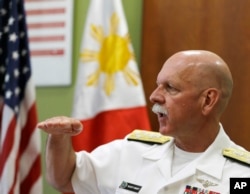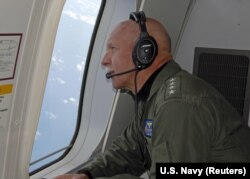The new commander of the U.S. Navy's Pacific Fleet is seeking to reassure regional allies that the pivot of American military forces will be sustained amid concerns regarding China's maritime expansion.
Since taking his post three months ago at the helm of the Pacific Fleet, Admiral Scott H. Swift has gone to the Philippines, South Korea, Japan, Australia, New Zealand and Malaysia to meet with counterparts in their navies.
In every one of those destinations there is “great angst” – due to the worrying “scale and scope” of Beijing's reclamation projects in the South China Sea, Swift told reporters on Tuesday.
“All of them have expressed concerns and uncertainty about what the future may hold. But, I think, what's most important is to come together in a multi-lateral way and approach reconciling these differences in claims within the region in a positive way and not allow the use of coercion or force as a lever to resolve to the benefit of one party or the other,” said the admiral.
Swift made the remark from Kuala Lumpur on a conference call with reporters in the region.
Skeptical about rebalance
VOA asked him about the skepticism expressed by U.S. allies regarding the Pentagon's long-term commitment of its much-publicized Pacific pivot.
“It's less a reflection of what the United States' ability is to support the refocus, it's more of a reflection of the angst in the theater, as you suggest, many in the countries are concerned about what the future is. And many of them are turning to the United States as a continued guarantor of the stability that they've enjoyed throughout the region, certainly for the last 70 years,” Swift replied.
The Defense Department's maritime security roadmap, released last week, has 60 percent of naval and aviation assets home ported in the Asia-Pacific region by 2020. Japan will be a cornerstone with Guam as a major strategic hub. There are to be partnerships with Vietnam and India – both rivals of China. And military joint operations are to be expanded with Indonesia, Japan and Malaysia.
“There's a whole litany of examples of how it's not just capacity that is forward deploying, but it's capability as well,” Swift said, explaining that he intends to ensure that the Pacific Fleet is the “force of choice to respond to any incident which may occur” in the region.
The Navy’s new aircraft carrier, USS Ronald Reagan, is to replace the USS George Washington this year.
More firepower in the region
Five years from now there will be considerably more firepower in the region.
Japan is to host the USS America, a new air operations-oriented amphibious assault ship, a pair of additional Aegis-capable destroyers and the latest class of stealth destroyers, known as the DDG-100.
The U.S. Marine Corps is to have F-35 joint strike fighters based at Iwakuni, Japan, the first overseas deployment of the advanced stealth aircraft.
An additional attack submarine and two more Virginia-class submarines will be based at Guam, a U.S. island that is about 2,500 kilometers away from both Japan and the Philippines.
Outreach to China's military
Admiral Swift, who formerly commanded the 7th Fleet, is also expressing hope of expanding contacts with China's navy and coast guard to try to “decrease the elements of instability that are occurring in the region.”
The Asia-Pacific Maritime Security Strategy report for 2015 devotes a considerable portion to China noting it is “using a steady progression of small, incremental steps to increase effective control over disputed areas and avoid escalation to military conflict.”
China makes claim to 90 percent of the South China Sea, overlapping claims of several countries, including the Philippines and Vietnam.
China blames the United States for heightening tensions in the resource-rich waters, which include one of the world’s busiest trade routes.









